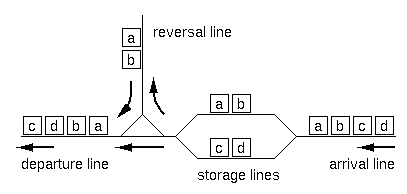Organize Your Train part II poj 3007 枚举
来源:互联网 发布:数据化人生小说 编辑:程序博客网 时间:2024/05/24 06:34
Description
RJ Freight, a Japanese railroad company for freight operations has recently constructed exchange lines at Hazawa, Yokohama. The layout of the lines is shown in Figure 1.

Figure 1: Layout of the exchange lines
A freight train consists of 2 to 72 freight cars. There are 26 types of freight cars, which are denoted by 26 lowercase letters from "a" to "z". The cars of the same type are indistinguishable from each other, and each car's direction doesn't matter either. Thus, a string of lowercase letters of length 2 to 72 is sufficient to completely express the configuration of a train.
Upon arrival at the exchange lines, a train is divided into two sub-trains at an arbitrary position (prior to entering the storage lines). Each of the sub-trains may have its direction reversed (using the reversal line). Finally, the two sub-trains are connected in either order to form the final configuration. Note that the reversal operation is optional for each of the sub-trains.
For example, if the arrival configuration is "abcd", the train is split into two sub-trains of either 3:1, 2:2 or 1:3 cars. For each of the splitting, possible final configurations are as follows ("+" indicates final concatenation position):
[3:1] abc+d cba+d d+abc d+cba [2:2] ab+cd ab+dc ba+cd ba+dc cd+ab cd+ba dc+ab dc+ba [1:3] a+bcd a+dcb bcd+a dcb+a
Excluding duplicates, 12 distinct configurations are possible.
Given an arrival configuration, answer the number of distinct configurations which can be constructed using the exchange lines described above.
Input
The entire input looks like the following.
the number of datasets = m
1st dataset
2nd dataset
...
m-th dataset
Each dataset represents an arriving train, and is a string of 2 to 72 lowercase letters in an input line.
Output
For each dataset, output the number of possible train configurations in a line. No other characters should appear in the output.
Sample Input
4aaabbaabcdabcde
Sample Output
161218
#include<cstdio>#include<cstring>#include<iostream>using namespace std;string s[550];int n;void init(){for(int i=0;i<500;i++)s[i]=""; n=0;}void Insert(string str){ for(int i=0;i<n;i++) if(str==s[i]) return; s[n++]=str;}int main(){ char str[75]; int length,last; string ch; string fore_pos,fore_neg,tail_pos,tail_neg; int t; cin>>t; while(t--) { scanf("%s",str); length=strlen(str); last=length-1; init(); ch=str; Insert(ch); ch=""; for(int i=last;i>=0;i--) ch+=str[i]; Insert(ch); for(int i=0;i<last;i++) { fore_pos=""; fore_neg=""; for(int j=0,k=i;j<=i;j++,k--) { fore_pos+=str[j]; fore_neg+=str[k]; } tail_neg=""; tail_pos=""; for(int j=i+1,k=last;j<length;j++,k--) { tail_neg+=str[k]; tail_pos+=str[j]; } Insert(fore_neg+tail_neg); Insert(fore_neg+tail_pos); Insert(fore_pos+tail_neg); Insert(fore_pos+tail_pos); Insert(tail_neg+fore_pos); Insert(tail_neg+fore_neg); Insert(tail_pos+fore_neg); Insert(tail_pos+fore_pos); } cout<<n<<endl; }}
- POJ 3007 Organize Your Train part II(枚举)
- Organize Your Train part II poj 3007 枚举
- POJ 3007 Organize Your Train part II
- POJ 3007 Organize Your Train part II
- POJ 3007 Organize Your Train part II
- POJ 3007:Organize Your Train part II
- poj-3007 Organize Your Train part II
- poj 3007 Organize Your Train part II
- POJ 3007 - Organize Your Train part II
- poj 3007Organize Your Train part II
- POJ Organize Your Train part II 3007
- poj-3007-Organize Your Train part II
- POJ 3007.Organize Your Train part II
- POJ 3007 Organize Your Train part II map+string
- 【POJ 3007】 Organize Your Train part II (字符串HASH)
- Organize Your Train part II【POJ--3007】【平衡二叉树】
- [POJ 3007]Organize Your Train part II[Hash][Trie]
- POJ-3007 Organize Your Train part II (字符串hash)
- 【bzoj3028】食物 母函数+乘法逆元
- centos学习笔记--资源查看部分
- 12.05
- Opencv处理鼠标事件
- css学习之二轮廓
- Organize Your Train part II poj 3007 枚举
- Kotlin-null的处理
- 用eclipse远程连接hadoop-2.6.0
- node.js 模块(Module)和包(Package)
- 03、模块加载过程解析
- 1619-7 张良 十二月五号总结 [连续第六十六天]
- 数据结构实验之排序一:一趟快排
- scrapy源码分析(八)--------ExecutionEngine
- NO.9 HTML继续走起


